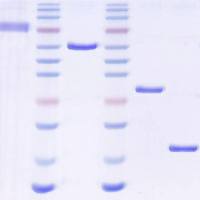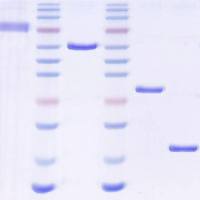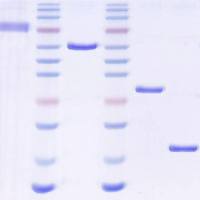Sucrose Fractionation of Castor Bean
互联网
Materials
Castor beans
Gradient former Sucrose solutions in 0.01 M EDTA, pH 7.5
33%, 44%, 50%, 57%, 60% (w/v)
Grinding Medium
0.4 M sucrose
0.165 M Tris-HCl buffer, pH 7.5
0.01 M KCl
0.01 M MgCl
0.01 M EDTA adjusted to pH 7.5
0.01 M dithiothreitol
Chopping board and knife or razor blade
Mortar and pestle
Cheesecloth
Refrigerated centrifuge (ultracentrifuge preferred) with swinging bucket rotor
Spectrophotometer and tubes
Hemacytometer and phase contrast microscope

Procedure
1.Germinate castor beans by soaking overnight, followed by germination in moist vermiculite, or paper towels, at 30° C.
Castor beans are poisonous and may be fatal if taken internally. Wear gloves while handling.
2.After approximately 5 days, remove the embryos and cotyledons and discard. Wash the endosperm in distilled water and chill on ice.
3.Prepare two centrifuge tubes for sucrose gradients; one for a linear 33-60% gradient and the other for a stepped gradient. The volume of each solution will depend on the centrifuge rotor to be used and its corresponding centrifuge tube capacity. The following are directions for 35 ml centrifuge tubes.
Stepped Gradient
Carefully layer, in order, the following solutions into a centrifuge tube
3 ml of 60% sucrose
6 ml of 57% sucrose
9 ml of 50% sucrose
9 ml of 44% sucrose
3 ml of 33% sucrose
Linear Gradient
Add 5 ml of 60% sucrose to the bottom of a centrifuge tube and form a linear 60 to 33% sucrose gradient on top of that. Using a gradient former, as shown in Figure 3.4, place 12 ml of 60% sucrose in the right chamber and 12 ml of 33% sucrose in the left chamber.
4.Combine 60 gm of endosperm tissue with 90 ml of grinding medium and chop vigorously.
5.Transfer the coarse material to a cold mortar and pestle and continue to grind until a fine paste is formed.
6.Filter the BREI (the paste from step 5) through two layers of cheesecloth. Collect the fluid into a beaker, transfer it to a centrifuge tube, and centrifuge the filtrate for 10 minutes at 270 xg to remove unbroken cells and large debris.
7.Decant the supernatant into a clean, cold centrifuge tube and recentrifuge for 30 minutes at 10,800 20xg. Resuspend the pellet in 5 ml. of grinding medium and hold on ice for further analysis.
8.Carefully decant the supernatant and save for subsequent analysis. Gently resuspend the pellet in 6 ml. of grinding medium.
9.Carefully layer 2 ml of the pellet onto a stepped sucrose gradient and 2 ml of the pellet onto a linear gradient.
10.Team up with another laboratory section and carefully balance your corresponding tubes. That is, be sure that the stepped gradients for both sections are exactly the same weight. Add grinding media to balance, where appropriate. Have the instructor check the balance before proceeding.
11.Centrifuge the tubes at 4° C for 4 hours at 25,000 RPM in a Beckman SW27 rotor or equivalent.
12.Upon completion of the centrifugation, fractionate the samples into approximately 20-30 equal portions. It is convenient to collect samples of 1.5 ml. This yields a volume suitable for subsequent spectrophotometric analysis without the use of small volume cuvettes.
This is accomplished most rapidly by gently inserting a long 18 gauge needle, with the tip ground off, into the centrifuge tube so that it rests on the bottom of the tube. Without moving the needle (so as not to stir the contents), attach a 2.0 ml syringe and pull out the bottom 1.5 ml of the sample. Remove the syringe and place the 1.5 ml fraction into a test tube marked as #1. Re-attach the syringe without disturbing the gradient, and repeat as often as need to totally fractionate the gradient.
Alternatively, the gradient can be fractionated by puncturing the bottom of the tubes with a needle, and collecting the fractions in 1.5 ml portions by counting the appropriate number of drops that drip from the punctured tube. There are several commercially available fraction devices designed for this purpose. If one is available, follow the manufacturer's directions.
13.Read the optical density (Absorbance) of each fraction in a spectrophotometer at 540 nm. Plot a double graph, with fraction number on the x axis (bottom to top) vs OD on the y axis, and fraction number vs % sucrose on the y axis.
14.Carefully examine all fractions with a phase contrast microscope. Identify and count (use a hemacytometer where appropriate) all structures found in each fraction.








